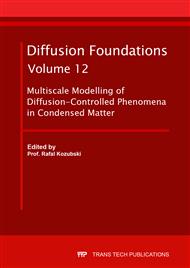[1]
R. Dobosz, M. Lewandowska, K. J. Kurzydlowski, The efect of grain size diversity on the flow stress of nanocrystalline metals by finite-element modelling, Scripta Materialia 67 (2012) 408–411.
DOI: 10.1016/j.scriptamat.2012.05.043
Google Scholar
[2]
R. Dobosz, M. Lewandowska, K. J. Kurzydlowski, FEM modelling of the combined effect of grain boundaries and second phase particles on the flow stress of nanocrystalline metals, Computational Materials Science 53 (2012) 286–293.
DOI: 10.1016/j.commatsci.2011.09.029
Google Scholar
[3]
R. Dobosz, M. Muzyk, Z. Pakiela, M. Lewandowska, K. J. Kurzydlowski, Simulations of the elastic properties of nanomaterials using multiscale modelling methods, Mechanics of Materials 67 (2013) 74–78.
DOI: 10.1016/j.mechmat.2013.07.010
Google Scholar
[4]
ANSYS® Academic Research, Release 18, Help System, Coupled Field Analysis Guide, ANSYS, Inc.
Google Scholar
[5]
J. Crank, The Mathematics of Diffusion. 2nd Edition, Oxford University Press, (1975).
Google Scholar
[6]
K. Krabbenhoft, J. Krabbenhoft, Application of the Poisson-Nernst-Planck equations to the migration test, Cement and Concrete Research, Vol. 38 (2008) Pages 77-88.
DOI: 10.1016/j.cemconres.2007.08.006
Google Scholar
[7]
O. Watanabe, H. M. Zbib, E. Takenouchi, Crystal plasticity: micro-shear banding in polycrystals using voronoi tessellation, International Journal of Plasticity, Volume 14, Issue 8, October 1998, Pages 771-788.
DOI: 10.1016/s0749-6419(98)00022-9
Google Scholar
[8]
S. Mahadevan, Y. Zhao, Advanced computer simulation of polycrystalline microstructure, Comput. Methods Appl. Mech. Engrg. 191 (2002) 3651–3667.
DOI: 10.1016/s0045-7825(02)00260-8
Google Scholar
[9]
Dong-Kyu Kim, Jae-Min Kim, Won-Woong Park, Ho Won Lee, Yong-Taek Im, Yong-Shin Lee, Three-dimensional crystal plasticity finite element analysis of microstructure and texture evolution during channel die compression of IF steel, Computational Materials Science 100 (2015) 52–60.
DOI: 10.1016/j.commatsci.2014.09.032
Google Scholar
[10]
M. Uchida, T. Tokuda, N. Tada, Finite element simulation of deformation behavior of semi-crystalline polymers with multi-spherulitic mesostructured, International Journal of Mechanical Sciences 52 (2010) 158–167.
DOI: 10.1016/j.ijmecsci.2009.09.002
Google Scholar
[11]
M. Nygards, P. Gudmundson, Three-dimensional periodic Voronoi grain models and micromechanical FE-simulations of a two-phase steel, Computational Materials Science 24 (2002) 513–519.
DOI: 10.1016/s0927-0256(02)00156-8
Google Scholar
[12]
L. Luoa, Z. Jianga, H. Lua, D. Weib, K. Linghuc, X. Zhaod , D. Wu, Optimisation of size-controllable centroidal voronoi tessellation for FEM simulation of micro forming processes, Procedia Engineering 81 ( 2014 ) 2409 – 2414.
DOI: 10.1016/j.proeng.2014.10.342
Google Scholar
[13]
M. Huang, Z. Li, J. Tong, The influence of dislocation climb on the mechanical behavior of polycrystals and grain size effect at elevated temperature, International Journal of Plasticity 61 (2014) 112–127.
DOI: 10.1016/j.ijplas.2014.06.002
Google Scholar
[14]
A. Rinaldi, D. Krajcinovic, P. Peralta, Ying-Cheng Lai, Lattice models of polycrystalline microstructures: A quantitative approach, Mechanics of Materials 40 (2008) 17–36.
DOI: 10.1016/j.mechmat.2007.02.005
Google Scholar
[15]
E. Legrand, J. Bouhattate, X. Feaugas, S. Touzain, H. Garmestani, M. Khaleel, D.S. Li, Numerical analysis of the influence of scale effects and microstructure on hydrogen diffusion in polycrystalline aggregates, Computational Materials Science 71 (2013) 1–9.
DOI: 10.1016/j.commatsci.2013.01.018
Google Scholar
[16]
H. Muto and M. Sakai, The large-scale deformation of polycrystalline aggregates: cooperative grain-boundary sliding, Acta mater. 48 (2000) 4161–4167.
DOI: 10.1016/s1359-6454(00)00169-5
Google Scholar
[17]
B. Osman Hoch, A. Metsue, J. Bouhattate, X. Feaugas, Effects of grain-boundary networks on the macroscopic diffusivity of hydrogen in polycrystalline materials, Computational Materials Science 97 (2015) 276–284.
DOI: 10.1016/j.commatsci.2014.10.048
Google Scholar
[18]
H. Mehrer, Difusion in Solids. Fundamentals, Methods, Materials, Diffusion-Controlled Processes, Springer Series in Solid-State Sciences 155, Berlin, (2007).
Google Scholar
[19]
S. Jothi , N. Winzer, T. N. Croft, S. G. R. Brown , Meso-microstructural computational simulation of the hydrogen permeation test to calculate intergranular, grain boundary and effective diffusivities, Journal of Alloys and Compounds 645 (2015) S247–S251.
DOI: 10.1016/j.jallcom.2014.12.247
Google Scholar
[20]
S.C. Tjong and Haydn Chen, Nanocrystalline materials and coatings, Materials Science and Engineering: R: Reports, Volume 45, Issues 1-2, September 2004, Pages 1-88.
Google Scholar
[21]
M.Hori, S. Nemat-Nasser, On two micromechanics theories for determining micro±macro relations in heterogeneous solids, Mechanics of Materials 31 (1999) 667-682.
DOI: 10.1016/s0167-6636(99)00020-4
Google Scholar
[22]
A. Dasgupta, R. K. Agarwal, S. M. Bhandarkar, Three-dimensional modeling of woven-fabric composites for effective thermo-mechanical and thermal properties, Composites Science and Technology 56 (1996) 209-223.
DOI: 10.1016/0266-3538(95)00111-5
Google Scholar
[23]
C. Zuorong, Z. Dechao, M. Lu, L. Ye, Evaluation of elastic properties of 3-D (4-step) regular braided composites by a homogenisation method, Composite Structures 47 (1999) 477–482.
DOI: 10.1016/s0263-8223(00)00026-x
Google Scholar
[24]
K. Long, X. Du, S. Xu, Y. M. Xie, Maximizing the effective Young's modulus of a composite material by exploiting the Poisson effect, Composite Structures 153 (2016) 593–600.
DOI: 10.1016/j.compstruct.2016.06.061
Google Scholar
[25]
C. Redenbach, Microstructure models for cellular materials, Computational Materials Science 44 (2009) 1397–1407.
DOI: 10.1016/j.commatsci.2008.09.018
Google Scholar
[26]
S. Kobayashi, R. Kobayashi, T. Watanabe, Control of grain boundary connectivity based on fractal analysis for improvement of intergranular corrosion resistance in SUS316L austenitic stainless steel, Acta Materialia 102 (2016) 397–405.
DOI: 10.1016/j.actamat.2015.08.075
Google Scholar
[27]
T. Lehmann, Ch. Reimann, E. Meissner, J. Friedrich, Clarification of the relation between the grain structure of industrial grown mc-Si and the area fraction of electrical active defects by means of statistical grain structure evaluation, Acta Materialia 106 (2016) 98–105.
DOI: 10.1016/j.actamat.2015.12.049
Google Scholar
[28]
R. Kirchheim, Stress and electromigration in Al-lines of integrated circuits, Acta Metallurgica et Materialia, vol. 40 (1992) Pages 309-323.
DOI: 10.1016/0956-7151(92)90305-x
Google Scholar
[29]
T. A. Ryumshina, S. P. Illyashenko, Study of stress and strain felds in an infnite plate exposed to hydrogen diffusion, International Journal of Hydrogen Energy 24 (1999) 825-828.
DOI: 10.1016/s0360-3199(98)00153-0
Google Scholar
[30]
S. Lee, W. L. Wang, J. R. Chen, Diffusion-induced stresses in a hollow cylinder: Constant surface stresses, Materials Chemistry and Physics 64 (2000) 123–130.
DOI: 10.1016/s0254-0584(99)00255-2
Google Scholar
[31]
Z. Wang, D. Shu, M. Wang, N. Ming, Strain effect on diffusion properties of oxygen vacancies in bulk and subsurface of rutile TiO2, Surface Science 606 (2012) 186–191.
DOI: 10.1016/j.susc.2011.09.014
Google Scholar


